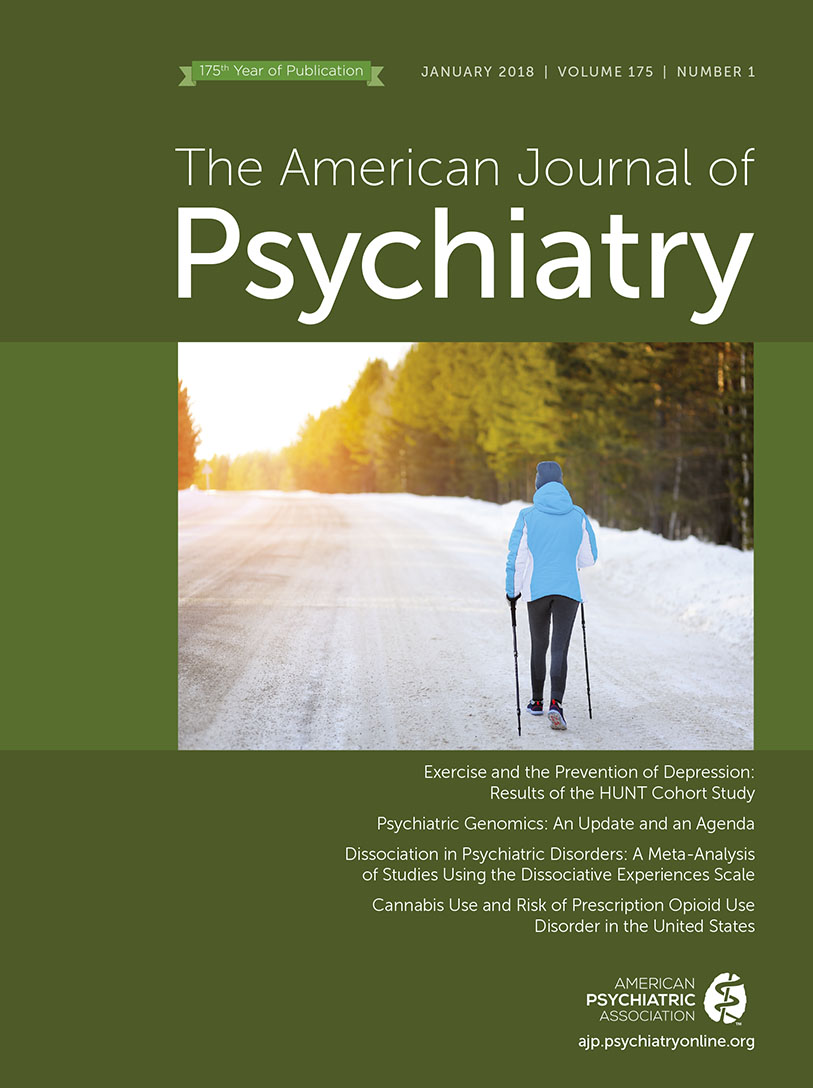Should Psychiatrists Write the Exercise Prescription for Depression?
Almost 20 years ago—before the word “green” became synonymous with marijuana—Swinburn and colleagues (1) popularized the term “Green Prescription” to refer to a primary care physician’s recommendation for regular physical activity. The Green Prescription for exercise was promoted as a broadly effective preventive strategy to reduce long-term risk of diabetes and cardiovascular disease.
In this month’s issue of the Journal, Harvey and colleagues (2) use population-based data from the Health Study of Nord-Trøndelag County (HUNT) to parse the longitudinal relationship between physical activity and depression. In a sample of 34,000 community residents free of significant depression or chronic medical illness at baseline, approximately 40% reported exercising for more than an hour per week. The remaining 60% who reported a lower level of exercise were 1.25–1.5 times more likely to have significant symptoms of depression when reassessed 11 years later. Assuming that this relationship is causal (i.e., physical exercise prevents depression rather than being a consequence of better mental health), approximately 12% of new cases of depression could have been prevented if everyone in the community had exercised at least an hour per day.
The prospective design offers some reassurance that the observed protective effect is actually casual. Exercise was assessed at baseline, and onset of depression was assessed 11 years later. Those with depression at baseline or known history of depression were excluded so that variation in exercise levels would precede depression rather than follow it. Those with significant impairment or disability related to medical illness at baseline were also excluded in order to help distinguish the effects of exercise from the confounding effects of chronic illness. Evaluation of possible mediators found only minimal evidence for reverse causation (subthreshold depression at baseline affected baseline exercise levels). Finally, the observed protective effect was specific to depression and not seen with anxiety. This specific effect offers reassurance that the findings do not represent just a general association of exercise with distress. Nevertheless, the authors acknowledge that some of the observed protective effects may reflect residual confounding rather than a true benefit of exercise. Consequently, the proportion of new-onset depression that might be avoided by a moderate level of physical activity is likely lower than 12%.
The authors also point out that excluding those with significant depressive symptoms or explicit depression history at baseline would not necessarily exclude all those with a prior episode of depression. Many of the “new-onset” depressive episodes observed in this sample may have been recurrences of depression in people with prior episodes not identified by this study’s brief baseline assessment. This methodologic critique, however, may be more of a boost to generalizability than a threat to validity. It is true that first onset of depressive disorder after age 20 (the lowest age included in the HUNT study) is more the exception than the rule. To achieve maximum population impact, depression “prevention” efforts in adults should probably focus more on prevention of relapse or recurrence than preventing the very first onset in those with no prior history of significant depression.
Analyses regarding dose-response effects and potential causal mechanisms have both theoretical and practical implications. Regarding dose-response, the maximum protective effect was observed at an exercise level of 1 hour per week, with no additional benefit for additional time exercising each week. Higher intensity of exercise also appeared to yield no additional benefit. Finally, protective effects were not explained by differences in resting pulse rate, a presumed marker for the physiologic effects of exercise on autonomic tone or cardiovascular fitness. At a theoretical level, these findings suggest that the depression prevention benefits of exercise occur via a different mechanism than that of the cardiovascular prevention benefits seen with more frequent or intensive exercise. At a practical level, these findings suggest that an exercise prescription for depression prevention could be a relatively easy pill to swallow: 1 hour a week of exercise that is vigorous enough to make you sweat.
Should psychiatrists and other mental health providers routinely write exercise prescriptions for the treatment of depression? We should consider this report from the HUNT study in the context of other evidence. As Harvey and colleagues point out, data from the HUNT study are directly relevant to prevention of depression rather than treatment. The HUNT study findings specifically support a recommendation for moderate exercise to prevent onset of (and likely recurrence of) depression. But we can also point to moderately strong evidence for exercise as a treatment for established depression, either as a stand-alone intervention for mild-to-moderate depression (3) or an augmentation option for more severe or treatment-resistant depression (4). We can conclude that exercise is a safe and moderately effective broad-spectrum antidepressant prescription—good for prevention and treatment across the spectrum of depression severity.
While the HUNT study followed a prospective design, psychiatrists and other mental health providers more often view the exercise-depression relationship retrospectively. We encounter patients with established depression and established patterns of physical inactivity. We often conclude that inactivity is a symptom or consequence of depression. These findings by Harvey and colleagues suggest that physical inactivity could more often be a cause of depression—and a potentially modifiable one.
1 : The green prescription study: a randomized controlled trial of written exercise advice provided by general practitioners. Am J Public Health 1998; 88:288–291Crossref, Medline, Google Scholar
2 : Exercise and the prevention of depression: results of the HUNT Cohort Study. Am J Psychiatry 2018; 175:28–36Link, Google Scholar
3 : Exercise for depression. Cochrane Database Syst Rev 2013; (9):CD004366Medline, Google Scholar
4 : Exercise as an add-on strategy for the treatment of major depressive disorder: a systematic review. CNS Spectr 2014; 19:496–508Crossref, Medline, Google Scholar



